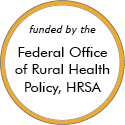Rural Project Examples: Illicit drug use
Evidence-Based Examples
keepin' it REAL Rural
Updated/reviewed April 2025
- Need: A drug and alcohol prevention program for middle school students that is specific to rural culture.
- Intervention: An adaptation of the evidence-based keepin' it REAL curriculum was customized for rural middle school students.
- Results: Students showed a reduction in all substance use and less personal acceptability of substance use.
Effective Examples
Vermont Hub-and-Spoke Model of Care for Opioid Use Disorder
Updated/reviewed November 2025
- Need: In the early 2010s, needed increase access to medication treatment for opioid use disorder in rural Vermont.
- Intervention: 2012-2016 implementation of a statewide hub-and-spoke treatment access system.
- Results: The original system's increased treatment capacity and care coordination successes now are a permanent system of integrated care overseen by the Vermont state health department and Vermont Blueprint for Health.
Other Project Examples
Arukah Institute's Living Room Program

Added December 2023
- Need: To address high rates of substance use in Princeton, Illinois and the surrounding area.
- Intervention: The Arukah Institute, a local nonprofit organization providing mental health services, adapted a statewide model to provide support and a safe space for people in need of substance use resources.
- Results: The Living Room program had 1,485 visits in its first year, with 100% of clients served by recovery support specialists.
For examples from other sources, see:
